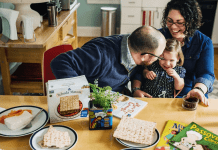My husband and I have walked into my late mother-in-law’s house for the last time.
We are in the process of settling her estate, including the sale of her house and disposition of everything in it.
From a hutch filled with china and crystal goblets to overflowing jewelry boxes and coin collections. And everything in between.
A lot in between.
Her clothes. The Notre Dame sweaters my late father-in-law was so fond of wearing. Her furniture. Furniture inherited from her mother-in-law, still in the same place in the garage where it was originally placed 30 some-odd years ago. My husband’s Cub Scout uniform. Christmas decorations. Lots and lots of Christmas decorations.
Every room, every closet, every shelf, every drawer. Full of stuff. A lifetime of stuff. Two lifetimes, if you count my father-in-law, who passed away 11 years ago.
What to Do With a Lifetime of Stuff
My mother-in-law was a neat and tidy housekeeper. But like many of us (myself included), she lived in a good-sized house with plenty of room to accommodate stuff. Things inherited from her parents and her in-laws. The broken vacuum cleaner waiting for repair in the back of the closet. Hundreds of books read once. You get the picture.
And the cost of disposing of all of that stuff? Having the estate sale company we hired go through every room, every closet, every drawer, separating the trash from the treasures, may cost more than will be generated at the eventual estate sale.
Her house has been transformed into a store, the estate sale company having cleverly arranged and displayed my mother-in-law’s possessions on tables in every room.
All of her possessions with any value, save the very few we kept, each with a tiny white price tag.
Losing your last surviving parent is hard enough. But being the arbiter of which of your parents’ and grandparents’ treasures get saved and which end up sold, donated, or in a landfill? gut-wrenching.
The lesson we have learned from this experience?
Most of the stuff in your house is worthless. And eventually, someone, either you or your kids, will be tasked with the overwhelming job of getting rid of it.
Most of Your Stuff Is Worthless
Most of the stuff in your house is worthless.
Yes, even the stuff you worry the most about, the stuff you think is so good you don’t use it for fear of breaking it, has little to no resale value.
From china, china cabinets, crystal goblets, silver tea sets, pianos, and collectible figurines like Hummels, to grandfather clocks and real pieces of craftsmanship furniture.
Why? Baby boomers have glutted the market with their castoffs, and millennials, the next generation of buyers, don’t want it.
Millennials hate both formal in-home entertaining and use of second-hand goods. With looming student loans, they tend to rent and move often. Who wants to be constantly moving a piano and a grandfather clock from apartment to apartment?
And furniture? There’s no market for so-called “brown furniture,” meaning any furniture (regardless of quality) other than the “mid-century casual” furniture (think clean, lightweight) favored by millennials. Brown furniture is basically firewood.
If it’s not in great condition, it’s also not fit for donation because it can’t be resold.
All of my mother-in-law’s furniture (including the pieces inherited from her mother-in-law and kept for decades)? Straight to the landfill.
Well, Almost Everything…
What do guns, LPs (records), and precious metals/gems have in common?
They are 3 things you might have in your house with a robust resale value.
Silverware also has value, but only if it is real silver and can be melted down.
3 Things You Should Be Doing NOW to Reduce the Amount of Stuff You Have
1. Be viciously thoughtful about holding onto sentimental items.
Here was our goal with sorting through my mother-in-law’s things. Keep just enough to remind us of her, but not so much stuff that our daughters are going to be dealing with it 40 some-odd years from now.
Here’s what we kept:
- A painting to be displayed in our dining room
- My mother-in-law’s treasured Swarovski crystal animal collection (all of which were given to her by her children and grandchildren over the years)
- Jewelry to be divided among the granddaughters
- Each of our daughters got to select 1 item
And that was it.
Well, almost. We did set aside photos to be digitized (with the originals then destroyed).
Was it hard leaving everything else? You bet it was. But we don’t want to be dealing with a lot of stuff years from now (or worse, leaving it to our daughters to deal with).
I try to be viciously thoughtful with my own sentimental items. For example, I don’t save any school papers or art projects from my kids (though I do take photos of my favorites).
2. Buy fewer books.
While used book resellers like Half Price Books do an important service in keeping books in circulation, a surprising number of books end up in landfills because many paper recycling facilities can’t process the the glue that binds book spines.
My resolution last year was to cut down on my book consumption by only reading books that I borrow from the library or purchase on my Kindle e-reader. If you haven’t used a library in years, now is the time to go back. My local library has an app where you can “order” books online, and pick them up the next day on a special “hold” shelf strategically placed next to the check-out kiosk.
How successful was I on my resolution? I read 1 to 2 books a week in 2019, only 1 of which was a hard copy purchased from Amazon.
3. Buy fewer, but better quality, clothes
The world is overflowing with used clothing.
We buy substantially more clothing over our lifetimes than our grandparents did.
Clothing made today is meant to last no more than a few years. In fact, a lot of clothing isn’t even made to withstand more than a few washes.
Think you are “paying it forward” but dropping off a load of unwanted clothes at Goodwill? Think again. Most clothing donations never make it to the racks at Goodwill and only about a third of what does eventually sells.
To really pay it forward, cut down on the amount of clothing you have by buying better quality clothes that last longer.
Keeping What Really Matters
My 5-year-old chose to keep a Christmas music box from her Grandma’s house. It plays “White Christmas” and has tiny ice skaters going around a rink inside. Each Christmas, my mother-in-law would bring out this music box and let each of her granddaughter’s play with it. It’s value in preserving a precious memory of Grandma? Priceless.














Just wanted to let you and other commenters know that the clothes that don’t sell at thrift stores go to third world countries so you are still paying it forward by donating unwanted clothes.
I agree with you, Dave. I have been to countless estate sales and estate auctions. I know of people who camp out the night before an estate sale to be the first in line. Most of these “campers” are dealers who resell the items in their shops, at antique markets, swap meets, and on websites like Ebay, Etsy, Craigslist and Everything But the House, to name a few. Yes, mid-century modern furniture is highly prized, especially in California, but so are other well made pieces of furniture including craftsman, chinoiserie and art deco pieces. I personally like to buy vintage, hand-cut crystal vases for $5 or $10 to give with flowers to friends on their birthdays—so much nicer than the cheap floral shop ones made in China. I’ve also bought framed art from listed artists, hand-knotted oriental rugs, and a beautiful Dux chair for my mid-century modern house for $60. (The same chair sells on 1stDibs for $2300!). I also had an Airbnb studio unit in a former house that was completely decorated with high quality vintage furniture, art work and even the bed (a pricy Sleep Number model in never-used condition) purchased from estate sales. The space was booked up 3 months in advance and many times I had bookings 6 months out. The comments many guests gave with their 5-star reviews—”beautifully decorated,” “charming interior,” “home away from home.” My point is, people will buy other people’s stuff. However, I do agree that most broken, chipped, and stained items have no value—dump them.
I so agree with this article, antique collectors notwithstanding. My family and I have been living this for the past two years; my mom lived in the same house for 45 years and had four generations worth of furniture and housewares from multiple families. When mom and my stepdad moved into a one bedroom retirement apartment, it was a massive undertaking to process, move, and donate things. I am eternally grateful to my mom for handling this while still alive, and I respect her a great deal for doing this. We’ve all kept a few mementos and it’s been liberating to let the rest go.
When my 90+ year old in-laws passed away, my husband (an only child) and I had the same issues. Multiple sets of china (each with a “history”) and enough crystal and glassware to fill tables in a two-car garage and two rooms in our home, plus furniture and miscellaneous kitchenware that we didn’t want or need. We had a “no-money-needed estate sale” and opened it up to friends, neighbors and our church. Almost everything was taken by people with a need. What was left, we packed up in one pickup and took to the Salvation Army. I can’t begin to tell you how many people came to me later to tell what a blessing it was to them. Crystal cake stands and serving pieces were selected by a young woman just starting her catering business. Newlyweds on a shoestring budget got a living room set. A young family who didn’t know how they would replace their washer that had just broken down were blessed with a set that, while not new, was much newer than what they had. What we learned is that it is better to give your children/grandchildren furnishings and such now if they need it, don’t hold it back for “someday.” By the time you pass on, they will have bought what they need and won’t want yours. Give it to them when they are struggling to make ends meet. And remember that once it is given, it is gone from your control. You can’t dictate how it is used or whether it’s sold or junked later–you’ll have no control anyway once you are gone.
Reaching old age, I made a decision. One of the things that I did not want to lose was family pictures, especially since I have mine, my Mothers, and my Grandmothers. I have chosen a younger family member in each family in the Clan, and I asked them if they wanted them. The pictures are being separated and sent to the appropriate person with a xeroxed note about what I am doing. If I go first, my husband would have no idea what to do with all these pictures. I cannot tell you how rewarding this has been. I got one thank you note from a cousin saying, “I can’t tell you how thrilled I am to get the pictures, “I had never seen my Daddy in a tie or my Mother in an evening gown.” My daughter and daughter-in-law took home bags as these can be shared with their children and grandchildren. I am also asking each child, grandchild, and great grandchild what they want out of the house. A list is being made that that both my husband and I know about what they want. Some family things that are treasures, to them they mean nothing to as they do not have an attachment to the person to whom the item belonged. My two cousins and I are genealogists for our family. Our Moms were sisters. We had reunions every two years and have extensive genealogy. Imagine my pride when three grandsons stated what they wanted. One wanted all the genealogy, the other two wanted something from the Clan. This is my beginning.
As a member of the local and wider area historical societies I must make a huge appeal to take a lot more care and deeper look at some of these so called “worthless” items. Many areas and people take great stock in trying to preserve our history. I have found a receipt for a church pew, yes, that’s right, proof that people really paid a subscription to have the right to sit in a church. You can not judge everything at immediate face value. If you are not interested in some of the treasures of the past, others might be. Make a bit of effort and see if someone can help you make those judgement calls. Then donate. Not only to the local history society, but the thrift store does give people employment, and is heavily used in most areas. If you don’t want it, place it on the curb for free, it will disappear, someone needs it.
Agreed, stop buying cheap. Look for quality items that will last, not just in clothing. There is a definite difference between what is bought at Ollie’s, for example, with everything stamped “Made in China”, vs. a handcrafted necklace or dining room table. You won’t be tempted to purchase as much when it isn’t a piece of junk. And by the way, the millennials are seeing value in a well made piece of furniture!
Have found these ideas to be true in the Austin area, where my daughters live. Mid Modern is quite popular, they don’t want the curvy, ornate wood carved furniture of the 19th century. It’s sad to know the value, and it is possible to get a better price by doing market place on FB to downsize.
People will regret getting rid of a lot of things — brown furniture, crystal, china, figurines etc for everything is cyclical and will come back in vogue.I say use it all! There’s nothing like drinking coffee or tea out of a china cup and drinking cold water out of a crystal goblet!
I suppose that “value” is in the eye of the beholder. I know that Ms.Kratovil would not be impressed with my collections from over 80 or 90 years but you know what: I don’t even care. Most of my belongings are very old but almost all of them present a memory to me and this is
why I treasure them. Don’t mess with my old stuff. Bee C in San Antonio.
What is considered quality clothing